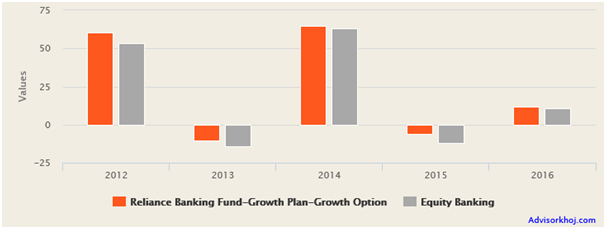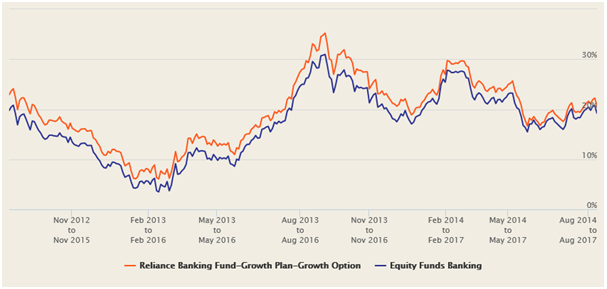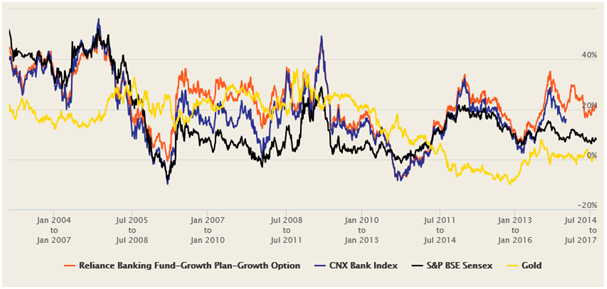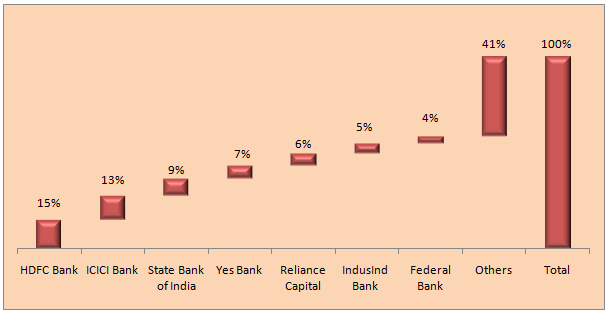Reliance Banking Fund: One of best banking sector mutual funds in last 5 years

Banking sector mutual funds have performed very strongly in the last one year or so, after underperforming in 2015. In the last one year banking sector mutual funds have given average returns of 27.5%. On a 2017 year to date basis, banking sector funds have given 31% returns. In just last 6 months, these funds have given average returns of nearly 17%.
While these high returns can be very tempting, we must caution investors that, sector funds can outperform the broader market by a big margin when market and economic conditions are favourable for the sector; at the same time, these funds can underperform considerably when the market conditions are unfavourable. Financial advisors, therefore, often advise investors to avoid these funds, unless the timing of entry is suitable.
As far as banking sector mutual funds are concerned, however, we have seen that, even over a long investment horizon, across different market conditions, these funds can give good returns to the investors. Banking sector mutual funds gave average annualized returns of more than 17% over the last 5 years. Therefore, in our view, even though sector funds should not form the core of your investment portfolio, depending on your risk appetite, you can tactically add these funds to your portfolio to get exposure to one of the most important and also, one of the fastest growing sectors of our economy.
Reliance Banking Fund is the oldest banking sector mutual fund scheme and is also one of the best performing in its product category in the last 5 years. The fund gave nearly 22% annualized returns to investors in the last 5 years. Rs 1 lakh invested in Reliance Banking Fund would have grown over Rs 2.7 lakhs in the last 5 years back. The Reliance Banking Fund was launched in May 2003 and has an Rs 3,033 Crores of Assets under Management. The expense ratio of the scheme is 2.04% only. Shrey Loonker is the fund managers of this scheme since 2010.
The chart below shows the annualized trailing returns of Reliance Banking Fund versus the banking fund category across different time-scales.

Source: Advisorkhoj Research
You can see that, Reliance Banking Fund outperformed the banking funds category across all trailing time-scales. The chart below shows the annual returns of Reliance Banking Fund versus the banking funds category over the last 5 years.

Source: Advisorkhoj Research
You can see that, the fund again outperformed every year, across different market conditions, over the last 5 years.
Lump sum Returns
Had you invested of Rs 1 Lakh in the NFO of Reliance Banking Fund (May 2003), your investment would have multiplied by 25 times in 14 years (the value as on 12/08/2017 is Rs 25.46 Lakhs). In the same period your investment of Rs 1 Lakh in CNX Bank Index or CNX NIFTY would have grown to only Rs 11.62 Lakhs and Rs 10.16 Lakhs – Please check this https://goo.gl/PL1A6u. The fund has given over 25% annualised return since its inception.
SIP Returns
A monthly SIP of Rs 5,000 since inception of Reliance Banking Fund would have grown to Rs 46.46 Lakhs against your investment of only Rs 8.55 Lakhs. The fund has given annual 21.52% XIRR returns! See the details here https://goo.gl/gM4uBV.
Rolling Returns
The chart below shows the 3 year rolling returns of Reliance Banking Fund over the last 5 years. Our regular readers know that, we use rolling returns to analyze the relative performance consistency of a mutual fund scheme in different market conditions.

Source: Advisorkhoj Rolling Returns Calculator
You can see that, the 3 year rolling returns of the fund consistently outperformed the banking funds category over the last 5 years. The rolling returns of Reliance Banking Fund were itself quite volatile; the maximum 3 year rolling return of the fund was around 35% and the minimum 3 year rolling return of the fund was around 6%. As discussed earlier, this volatility is to be expected because these sector funds can show significant outperformance or underperformance relative to the broader market at different periods. The average 3 year rolling returns of the fund was 19.5%. The fund gave in excess of 15% rolling returns, around 73% of the times over the last 5 years.
Let us now look at another interesting rolling returns analysis, which reveals useful insights about the fund manager’s abilities and the banking sector’s potential versus different asset categories. For this analysis, we have looked at the 3 years rolling returns of the fund since inception (2003), so that we can understand the impact of the crash of 2008, as well as the bull market that preceded it on Reliance Banking Fund and different asset categories. The chart below looks a little complicated, but on careful examination will reveal some useful insights for our readers.

Source: Advisorkhoj Rolling Returns versus Gold and Sensex
Let us first analyze the scheme performance relative to the benchmark CNX Bank (or Nifty Bank) and the BSE Sensex, which is our benchmark for equity as an asset class. In the first few years after launch, the rolling returns of the scheme were mostly in line with that of the benchmark; at times it slightly outperformed the benchmark and at times it underperformed slightly. A new scheme can take some time to mature and outperform the benchmark. You can see that, post 2008 Reliance Banking Fund consistently outperformed the benchmark index, a testimony to the scheme’s maturity.
You can also see in the chart above that, prior to 2009, Sensex outperformed both the Reliance Banking Fund and also the CNX Bank index. This is primarily because the private sector banking industry was not fully mature (to the extent it is now) back then. Nonetheless, you may note in the chart above the 3 year rolling returns of Reliance Banking Fund prior to the 2008 crash was always above 20%. The banking sector, however, was among the worst hit sectors in the crash of 2008. Yet it was primarily the banking sector, which led the stock market’s recovery in 2009 and today is considered the most important sector in the market. You can see that, since the recovery from the 2008 crash, both Reliance Banking and CNX Bank index have outperformed the Sensex.
Let us now analyze the performance of Reliance Banking Fund versus Gold. You can see that, Reliance Banking Fund outperformed Gold prior to the 2008 crash. It is only natural that a safer asset class like Gold will outperform equity in a severe bear market. But during the market recovery post the 2008 crash, Reliance Banking Fund outperformed Gold. The 2010 to 2013 period was extraordinary period for Gold; Gold gave exceptionally high returns and for the most of this period, outperformed equity as an asset class. This was primarily the after effects of the seismic event of 2008 and investors around the world were still very nervous about equity as an asset class. However, post 2013, Gold gave negative returns and though prices recovered somewhat in 2016, gold returns are still very low. Equity, as an asset class in general and Reliance Banking Fund have outperformed Gold with a huge margin post 2013.
Portfolio Construction
The fund manager has a large cap bias for the scheme portfolio. The portfolio turnover is fairly low. The scheme portfolio is somewhat concentrated with the top 7 stocks account for 60% of the portfolio assets (please see the waterfall chart below). For the last few years HDFC Bank was the top stoc kholding of this scheme. Bank stocks account for around 60% of the portfolio value and financial services constituting the balance. Approximately 6% of the portfolio assets are in cash and cash equivalents.

Source: Advisorkhoj Research
Conclusion
The Reliance Banking Fund has delivered over 14 years of strong performance. The strong macros of the Indian economy and a favourable interest regime make this fund a good long term investment. Investors with high risk appetite and long investment horizon can consider investing in Reliance Banking Fund either through the systematic investment plan (SIP) or lump sum route. Prior to investing, you should consult with your financial advisor, if the fund’s risk / return characteristics (discussed in this post) are suitable for your investment objectives and horizon.
Mutual Fund Investments are subject to market risk, read all scheme related documents carefully.
Queries
-
What is the benefit of mutual fund STP
Aug 29, 2019
-
How much to invest to meet target amount of Rs 2 Crores
Aug 26, 2019
-
Can I achieve my financial goals with my current mutual fund investments
Aug 24, 2019
-
Can you tell me return of various indices
Aug 19, 2019
-
What would be the post tax return on different investments
Aug 18, 2019
-
Which Principal Mutual Fund scheme will be suitable for my retirement corpus
Aug 16, 2019
-
What is the minimum holding period for availing NCD interest
Aug 4, 2019
Top Performing Mutual Funds
Recommended Reading
Fund News
-
The Wealth Company Mutual Fund launches The Wealth Company Gold ETF FOF
Jan 9, 2026 by Advisorkhoj Team
-
Mahindra Manulife Mutual Fund launches Mahindra Manulife Innovation Opportunities Fund
Jan 9, 2026 by Advisorkhoj Team
-
Jio BlackRock Mutual Fund launches Jio BlackRock Short Duration Fund
Jan 8, 2026 by Advisorkhoj Team
-
Jio BlackRock Mutual Fund launches Jio BlackRock Low Duration Fund
Jan 8, 2026 by Advisorkhoj Team
-
Groww Mutual Fund launches Groww Small Cap Fund
Jan 8, 2026 by Advisorkhoj Team














